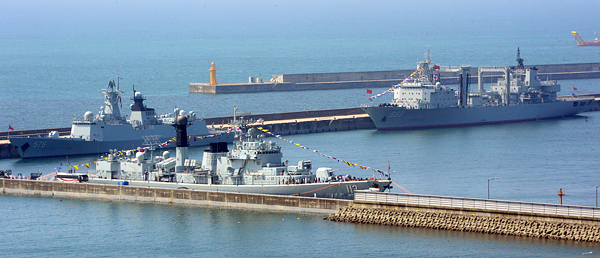U.S. and Indian navies face tension with China

The Chinese Navy’s 4,053 Daqing frigate, also referred to as a mini-Aegis warship, is docked at Korea’s Naval Operations Command in Busan after arriving on June 23. It is equipped with a 32-cell vertical launching system and able to launch HQ-16 mid-range surface-to-air missiles with a range of 30 kilometers (18.7 miles). [NEWSIS]
On June 22, three Indian Navy vessels, including the 6,200-ton stealth warship INS Sahyadri, arrived at the Busan naval base.
The Sahyadri, a missile-guided frigate first commissioned in 2012, is one of the Indian Navy’s newest warships and is equipped with a 32-cell vertical launching system (VLS) that is capable of firing Israeli Barak-1 short-range surface-to-air missiles.
The following day, a Chinese Navy squadron arrived at Busan ports, comprising a 4,053-ton multi-role frigate Daqing, a 4,200-ton destroyer Qingdao and a supply ship.
The squadron had completed a six-month anti-pirate mission in the Gulf of Aden off the coast of Somalia and stopped by Busan for a friendly exchange with the Korean Navy.
Like the Sahyadri, the Daqing vessel is equipped with a 32-cell VLS and able to launch HQ-16 surface-to-air missiles with a range of 30 kilometers (18.7 miles).
Earlier this month, the United States, Japan and India conducted a large-scale joint naval drill in the Western Pacific, during which a Chinese spy ship was reported to have shadowed parts of the joint exercise.
The United States and India have growing defense and security cooperation and have held the Malabar naval exercises since 1992, which Japan joined last year.
However, China and India have a competitive relationship. In late May, China protested Indian Navy ships taking part in maritime exercises in the South China Sea.
After docking in Busan, India hosted a dinner reception on the Sahyadri that was attended by U.S. Ambassador Mark Lippert, Rear Adm. William Byrne, commander of the U.S. Naval Forces Korea, and other American and Korean naval officials.
An Indian naval officer asserted that “freedom of navigation has to be guaranteed” in the South China Sea, according to a Korean naval official.
While this is a position that Washington has often emphasized, China has responded sensitively to such remarks.
Beijing claims sovereignty over the South China Sea region and several island chains within it, a claim disputed by Malaysia, Vietnam, Brunei, the Philippines and Taiwan.
The top U.S. envoy’s presence at the reception was also seen as an implicit message in the joint efforts to contain China’s expanse in the South China Sea.
Adding to the tension, the Indian vessels were docked at a port near the U.S. Naval Forces Korea, which is located within Korea’s Naval Operations Command in Busan.
Meanwhile, the Chinese naval vessels were docked by a port opposite to them.
China the next day held a reception on the Daqing frigate, inviting aboard Korean naval officers, but it did not extend an invitation to the Indian naval officers docked nearby - nor the U.S. Naval Forces Korea.
BY KIM MIN-SEOK, SARAH KIM [kim.sarah@joongang.co.kr]










with the Korea JoongAng Daily
To write comments, please log in to one of the accounts.
Standards Board Policy (0/250자)